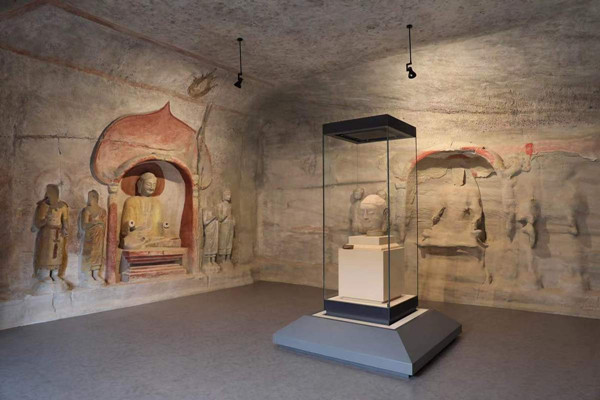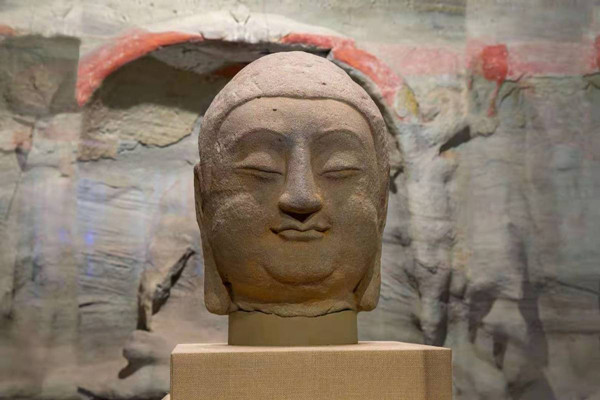Lost Buddha sculpture returns to North China grottoes
Updated: 2021-07-26

The lost Buddha head statue returned to the Tianlongshan Grottoes in Taiyuan is seen on display on July 24, 2021. [Photo by Li Rui for China Daily]
Nearly one century after it was lost, a Buddha head statue repatriated from Japan finally returned to its home in the Tianlongshan Grottoes in Taiyuan, North China's Shanxi province, on Saturday.
The head, dating back to the Sui Dynasty (581-618), was originally set on the northern wall in the No 8 Tianlongshan Grottoes, and it was believed to be stolen and lost overseas in about 1924, according to an appraisal by an expert panel organized by the National Cultural Heritage Administration.
The No 8 Cave was the largest grotto in Tianlongshan, where massive carving of Buddhist caves lasted from the 6th to early 8th centuries, and is the only one with a specific date of construction (AD 584).
To welcome its return, a special exhibition opened on Saturday in the Tianlongshan Grottoes Museum in Taiyuan to comprehensively review its history through cultural relics, pictures, digitization and 3D-printing technology.
According to the expert panel, this smiling Buddha with typical artistic features of its time represents extraordinary craftsmanship and high academic values.
Tianlongshan was the most heavily ransacked Chinese Buddhist grotto site by foreign hands in that time of history. About 240 Buddha images were looted in the 1920s, shortly after it was widely known by foreign explorers, and almost none of the caves survived in the havoc.
About 150 of the statues are now housed in overseas museums and private collections, and the whereabouts of the rest remain unknown.

A Buddha head statue repatriated from Japan rests in its home at the Tianlongshan Grottoes in Taiyuan, North China's Shanxi province. [Photo/The National Cultural Heritage Administration]
This 44.5-cm-high Sui Dynasty Buddha head is the first among these stolen items to be returned from Japan, according to Li Qun, director of the National Cultural Heritage Administration.
"The fate of cultural relics is linked to the destiny of a country," Li said at the return ceremony on Saturday. "Its journey home reflects Chinese people's patriotism, no matter whether they live at home or abroad, and it's a note marking a nation's rejuvenation."
The National Cultural Heritage Administration learned in September a Chinese Buddha head statue labeled as from the Tang Dynasty (618-907) was about to be auctioned in Tokyo, and was suspected to be a stolen piece from Tianlongshan.
The administration soon began the process of repatriation. In October, the auction house in Tokyo, whose board chairman Zhang Rong is a Chinese from Hangzhou, East China's Zhejiang province, agreed to cancel the auction.
After negotiations between the National Cultural Heritage Administration, Zhang, and the local holder of the relic in Japan, the Buddha head was bought by Zhang and finally donated back.
The lost relic was transferred to the Chinese Embassy in Tokyo in November, and it arrived in Beijing in December.
Zhang was given 300,000 yuan ($46,000) by the Chinese government as a bonus for his contribution rescuing the lost relic, but at the return ceremony in Taiyuan, he announced the donation of the entire reward to support repatriation of more lost Chinese relics.



